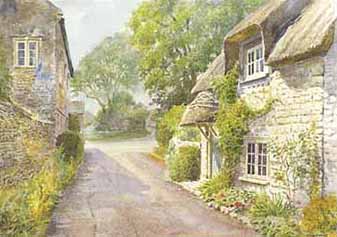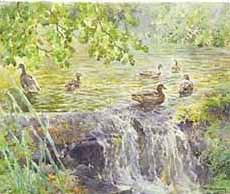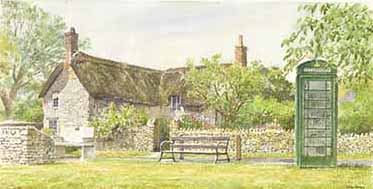Village walk – Portesham
Clive Hannay in the village that was the home of Nelson’s flag-captain
Published in November ’19
 ANDREW RICCARD was born in humble circumstances in Portesham at the beginning of the 17th century. He went to sea as a boy, but his commercial abilities were soon apparent and he ended up as Governor of the East India Company and the Turkey Company, a Sheriff of the City of London and an MP. When he was knighted in 1660, he chose as his Latin motto the word for ‘I can’ in that language: possum. His choice was a clever pun, because the name of his home village has always been shortened in the Dorset dialect to ‘Possum’. Thus the week-long fair held annually in early August until the outbreak of World War 1 was not Portesham Festival Week but Possum Fes’ Wik.
ANDREW RICCARD was born in humble circumstances in Portesham at the beginning of the 17th century. He went to sea as a boy, but his commercial abilities were soon apparent and he ended up as Governor of the East India Company and the Turkey Company, a Sheriff of the City of London and an MP. When he was knighted in 1660, he chose as his Latin motto the word for ‘I can’ in that language: possum. His choice was a clever pun, because the name of his home village has always been shortened in the Dorset dialect to ‘Possum’. Thus the week-long fair held annually in early August until the outbreak of World War 1 was not Portesham Festival Week but Possum Fes’ Wik.
The name ‘Possum’ was used by Portesham’s perhaps most famous son whenever he referred to his home village. Thomas Masterman Hardy was Nelson’s flag-captain on HMS Victory at Trafalgar (‘Kiss me, Hardy’) and went on to become a full admiral himself and Governor of Greenwich Hospital. He lived in Portesham House, on the corner of Front Street and the B3157 Bridport-Weymouth coast road. Originally Tudor, it was given an elegant Georgian façade around 1800. It is certainly more becoming than the cut-off industrial chimney that stands on Black Down above the village as the official monument to Admiral Hardy.
 In the shadow of that monument is a relic that predates it by some 5000 years. The Hellstone is a Neolithic dolmen, that is a burial chamber which was probably covered originally by a long barrow. It would have consisted of a ‘roof’ or capstone, supported on stones placed vertically. In 1862 the capstone fell and four years later, the structure was restored by well-meaning but ignorant amateurs. The nine flat stone supports were turned so their edges faced inwards, which they almost certainly would not have done in the original dolmen.
In the shadow of that monument is a relic that predates it by some 5000 years. The Hellstone is a Neolithic dolmen, that is a burial chamber which was probably covered originally by a long barrow. It would have consisted of a ‘roof’ or capstone, supported on stones placed vertically. In 1862 the capstone fell and four years later, the structure was restored by well-meaning but ignorant amateurs. The nine flat stone supports were turned so their edges faced inwards, which they almost certainly would not have done in the original dolmen.
Despite the bungled restoration, the Hellstone is strongly atmospheric. The 19th-century enthusiasts hired Portland quarry men to bring their ‘Portland jacks’ to lift the sixteen-ton capstone into place; it is almost impossible to conceive of the ingenuity and manpower that the original builders must have had to summon to achieve the same task. Inevitably, folklore has a fanciful explanation for the Hellstone: that it was thrown here by the devil while he was playing quoits on Portland.
Like the Hellstone but in quite a different way, the parish church of St Peter is very atmospheric. It has no exceptional features, but, unlike the Hellstone, it at least escaped the attentions of Victorian restorers. In the 1920s, its 13th-century tower was covered in ivy. When it grew to obscure the clock face, the remedy agreed by the villagers was to shoot it away with shotguns, which one would have expected to defeat he original object of the exercise.
 Between dolmens and admirals, Portesham’s life has continued as serenely as one would expect in a small Dorset village. In 1644 there was a Civil War skirmish in which the Cavaliers came off rather better, capturing 40 Roundhead horses and one of their officers. In the run-up to D-Day, like many places close to their embarkation points in Weymouth and Portland, Portesham was temporarily home to many American troops. Joe Louis, the former world heavyweight champion, paid them a visit and a boxing ring was erected in his honour but, to general disappointment, he used it only as a rostrum from which to address the audience.
Between dolmens and admirals, Portesham’s life has continued as serenely as one would expect in a small Dorset village. In 1644 there was a Civil War skirmish in which the Cavaliers came off rather better, capturing 40 Roundhead horses and one of their officers. In the run-up to D-Day, like many places close to their embarkation points in Weymouth and Portland, Portesham was temporarily home to many American troops. Joe Louis, the former world heavyweight champion, paid them a visit and a boxing ring was erected in his honour but, to general disappointment, he used it only as a rostrum from which to address the audience.
The main road through the village, onto which you will turn if using the coast road, or down which you will come if approaching from the north, is Front Street. Park as close as you can to the bottom of Front Street and its junction with the B3157, near the village green with its green telephone box. Walk up Front Street, where a stream chuckles down the left-hand side. St Peter’s church is also on the left. Take care because for most of its length, Front Street has no pavement.
Where the road bends sharply to the right, there is a choice. Turning left and following Back Street back to your car will give you a good sense of the village in a circuit which is less than half a mile.
For the more vigorously inclined, there is a walk which is a little over 3 miles and includes a number of climbs and ascents, but which shows off the countryside around Portesham, includes a visit to the Hellstone and offers some magnificent views. To follow this route, stay on the road for another 90 yards after the sharp right bend and turn right along a paved track. When this becomes a rough track, continue straight ahead to climb the flank of the hill. The track swings to the right and, at the end of a wall, turns sharp left. Stay on this track as it bears to the right. A gate marks the top of the hill, with a wonderful view to enjoy as you stop to catch your breath.
Descend to the next gate, beyond which turn left on a track which bears to the right and descends. Immediately after passing between two ruined buildings, bear left, then about 25 yards before a gate, turn left onto a path that leads to a stone stile. Go straight on, along the bottom of three fields. About 60 yards after crossing into the third field, cross a stone stile on the left and walk up the right-hand field-edge to visit the Hellstone. Then retrace your steps down the field again, cross the stone stile and turn left.
Cross a double stile into an open field and follow a post and wire fence on the right. Approaching the other side, bear left to a gate visible about 100 yards down from the corner. Don’t go through this gate but turn left and follow the hedge round to the right, to a smaller gate. Cross the road and follow a track that runs to the left of a barn. Stay on this track, with a stupendous view from White Nothe, through Weymouth Bay, Portland, Chesil Beach, the Fleet and St Catherine’s chapel at Abbotsbury to, on a good day, most of Lyme Bay.
The track enters an open field, at the end of which go through the small gate on the left and follow the path round to the left down to another gate. Beyond that, turn left on a well-defined path that runs through brambles and gorse along the edge of a valley. Where it emerges onto the open hillside, bear right, down to a fence, and keep this fence on the left, with the steep side of the valley immediately on the right.
At the end of the field, turn right to descend into the valley and, when possible, double back to the left and walk down to a gate to the left of a wood. Follow the track beyond, which, after a slight rise, bends to the left and reaches a gate. Follow the right-hand field-edge, go through two gates and, at the top of the rise beyond, ignore the big gate ahead and go through a smaller one on the right onto a path. Follow this path all the way down to Back Street, where turn right. At a cross-roads, go straight ahead into New Road to return to your car.

